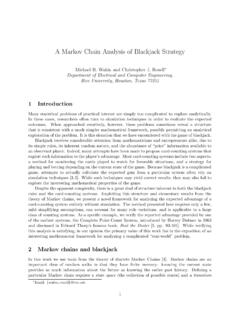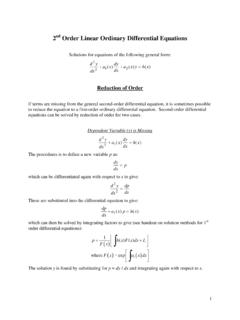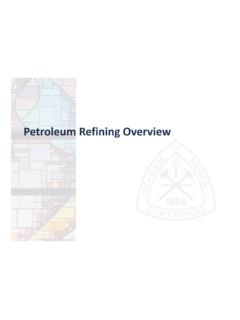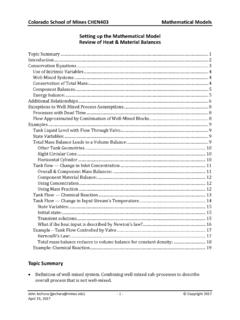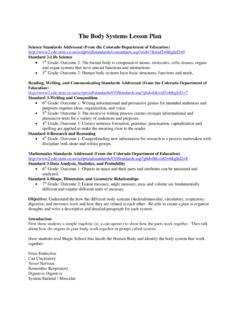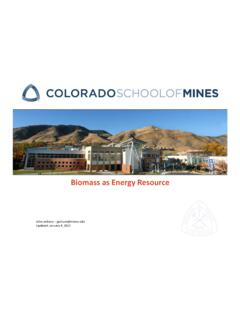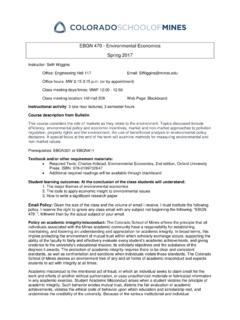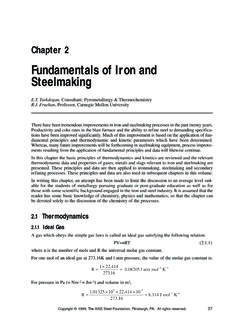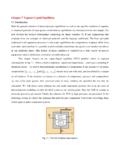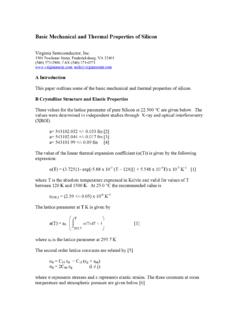Transcription of Water Chemistry 3 - Inside Mines
1 1 Water Chemistry 3 Controls on Water ChemistryChemical Equilibrium ActivitySaturation IndexCarbonate Equilibrium and AlkalinityAt equilibrium both reactions happen simultaneouslyA + B C + DA + B C + DRecall: LAW OF MASS ACTION indicates that a system strives to equilibriumA + B C + DA chemical reaction can be written asaA + bB cC + dDa b c d are molar proportions of compounds A B C D( stoichiometric coefficients in a balanced chemical equation)2[][][][]constantK==badcBADCEQU ILIBRIUM CONSTANT[A] [B] [C] [D] represent equilibrium molal or molar concentrationa b c d are molar amounts of compounds A B C DK is the equilibrium constant (tabulated in aqueous chem books)
2 If one compound changes concentration others adjust to maintain KFor equilibrium evaluations the [ ] of a pure liquid or solid is defined as 1 Depending on the type of reaction, K may be calledacidity or dissociation constantfor acid/base reactionscomplexation constantfor complexation reactionssolubility productfor dissolution reactionadsorption constantfor surface reactions[][][][]badcBADC=KGivenIf a reactant, say A, increasesthen to maintain equilibrium:the reaction must shift to the rightactivities of reactants decreaseactivities of products increasekeepingKconstantaA + bB cC + dDandReactants Products3 ACTIVITYIn concentrated solutions, ions interact electrostatically with each other (surrounded by a cloud of opposite charge) so the stoichiometriccoefficients do not reflect reactive availabilityActivity coefficients adjust molal/molar concentrations M to effective concentrations called activities, aa = (M)
3 Activity is proportional to concentration, and the proportionality constant is the activity coefficient, Activity Coef. depends on temperature, pressure & total compositionIn dilute solutions, the dissolved components are spread far apart, so interactions among them are very weak then i 1, so ai MiIn concentrated solutions a & M may be far from equalEstimating activity coefficient Iion particular on the charge thezT & P solvent,on dependingconstant aA whereAzlog2== =iii I Debye-H ckel method (accurate up to I~ )G ntelberg method (accurate up to I~ M)1/21/221) (zlogII ii+ =Activity depends on ionic strength Iof a solution.
4 Langelierby TDS(mg/L))10( m wherezm2152 = IIii4chargez T, & Pon dependingconstant AAzlog2== =iii I Debye-H ckel method (accurate up to I~ )Thus we simplify to:G ntelberg method1/21/221) (zlogII ii+ = 60 @ and 0 Typically ion of radius hydrateda T, & Pon dependingconstant 1 Azlog2=== ==+ =CCACAtBBIBa I ooooooiiFor higher ionic strengths Debye-H ckel developed:A bit of elaboration on the source of the G ntelberg methodDetermine the Ionic strength and Ca and HCO3activity for Denver waterpH = , Temp = 20 x 10 x 10 -342Ca+2-179 TDSConc.
5 (mol/L)Conc. (mg/L)ConstituentDetermine the ionic strength in solution based on TDSD etermine activity coefficients for HCO3-usingG ntelberg methodDetermine activity coefficients for Ca+2 usingG ntelberg method5 CHEMICAL EQUILIBRIUM Thermodynamics vs. KineticsThermodynamics tells us where the system should go at equilibrium, and kinetics tells us how fast. Definition of Equilibrium1) A system at equilibrium has none of its properties changing with time, no matter how long it is observed2) A system at equilibrium will return to that state after being disturbed3) Thermodynamically speaking, a system is at equilibrium when rG (the change in Gibbs Free Energy) = 0 Gibbs Free Energyis a thermodynamic quantity which can be used to determine if a reaction is spontaneous or not.
6 Gibbs free energy is G = H(enthalpy) - T(temp) * S(entropy)Enthalpy (useful work you can get from a closed system)InternalE+SurroundingP*VolumeEntr opy (a quantitative measure of a system s disorder)when ice melts entropy increasesCHEMICAL EQUILIBRIUMA and B react to produce C and D (a,b,c,d are number of moles)aA + bB = cC + dDThe Gibbs free energy change of reaction is calculated: =reactantsfproductsfrG G G rG= c fGC+ d fGD-a fGA-b fGBIf rG = 0, the reaction is at equilibriumif rG < 0, the reaction will proceed to the rightif rG > 0, the reaction will proceed to the leftMultiply Gibbs free energies of formation ( f G) by stoichiometric coefficients and subtract sum of reactants from sum of productsReactants ProductsGibb s free energies of formation are determined by experimentFor Some Gibb s Free Energy ~epoeter/_GW\19 WaterChem3 and Gibb s Free Energy are Related.
7 RT logKor =[][][][]badcBADC=K =reactantsfproductsfrG G G Go-Gibbs free energy change of reaction at standard stateR gas constant energy per degree Kelvin per moleT Temperature Degrees Kelvin K= C+ converts ln to logHow much of a substance will dissolve in Water ?SOLUBILITY PRODUCTS uppose we have the dissolution reaction for anhydrite:CaSO4(s) Ca2++ SO42-in this case K equilibrium constant is asolubility product (KSP) + +===2424242 SOCa(s)CaSOSOC aspaaaaaKKactivity of most pure solids can be taken equal to unity (so aCaSO4(s)= 1)Calculate KSPby finding the Gibbs free energy change of reaction: rG = f G Ca2++ f G SO42-- f G CaSO4(s)and logKorSP =7 Calculate the solubility product of anhydrite at 25 CCaSO4(s) Ca2++ SO42-Look up.
8 ~epoeter/_GW\19 WaterChem3 f G Ca2+= kJ mol-1 f G SO42-= kJ mol-1 f G CaSO4(s)= kJ mol-1R (gas constant) = J K-1mol-1so: rG = + ( ) - ( ) = kJ )( )molKJ( , logK111orSP = = = SOLUBILITY PRODUCT assume Kelvin for thermodynamic expressions, unless noted otherwiseWill a substance dissolve or precipitate?ION ACTIVITY PRODUCT (IAP)Consider again:CaSO4(s) Ca2++ SO42-Equilibrium constant in terms of activities of reactants & products at equilibriumHowever, a real solution may or may not be in equilibrium. The ion activity product(IAP )has the same form as the equilibrium constant, but involves the actual(measured)activities:()()equilSOeq uilCa242aaK +=()()actualSOactualCa242aaIAP +=If IAP = K, the solution is in equilibrium with anhydriteif IAP < K, the reaction will proceed to the right (dissolution)if IAP > K, the reaction will proceed to the left (precipitation)8 Will a substance dissolve or precipitate?
9 THE SATURATION INDEXThe saturation index (SI) is defined as:IAP= KSP SI = 0 ( < SI < ) Water is saturatedwith the mineralIAP< KSP SI < 0water is undersaturatedwith the mineralReaction is proceeding from left to right (dissolution)IAP> KSPSI > 0water is supersaturatedwith the mineralReaction is proceeding from right to left (precipitation) =SPKIAPlogSISuppose a groundwater analysis indicates5x10-2mol/L Ca2+and 7x10-3mol/L SO42-(ignore activity coefficients)Is this Water saturated with respect to anhydrite? CaSO4(s) Ca2++ SO42-CaSO4(s) Ca2++ SO42-First, calculate the IAPR ecallpH = -log a H+ soaH+= 10-7 Consider the acid-base reactionH2CO3 HCO3-+ H+K= way should the reaction go if pH = 7 aH2CO3= 10-4aHCO3-= 10-3?
10 IAP> K(10-6> )The reaction will shift to the left until IAP= Kso more H2CO3will be formed()()()6473 COHHHCO10101010aaaIAP323 ===+ 9 Picture by Anthony MirallesWhether your concern is domestic Water , spa Water , or a fish tank, you will want to know about carbonate EQUILIBRIUMMost important acid-base system in Water , controls the pH of most watersWater exposed to the atmosphere dissolves carbon dioxide CO2(g)creating carbonic acid H2CO3CO2(g) + H20 CO2(aq) Gas dissolutionCO2(aq) + H20 H2CO3 Carbonic acid formationCarbonic acid dissociates in two steps1) Carbonic acid donates one proton (H+) to create bicarbonate HCO3-H2CO3 H++ HCO3-2) Bicarbonate donates a proton (H+) to form carbonate CO32-HCO3- H++ CO32-pK2= H++ CO32-pK1 = H++ HCO3-pKH= (aq) + H20 H2CO3 Equilibrium constant (25oC)

